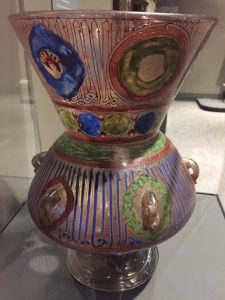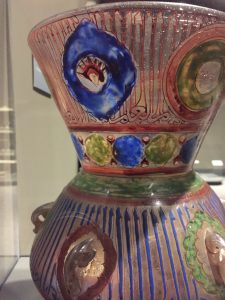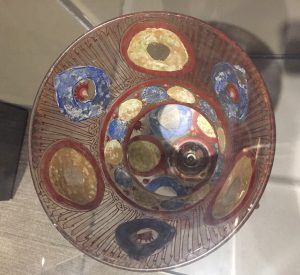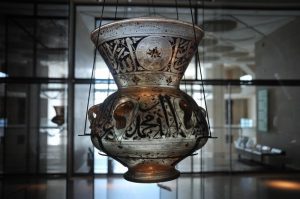Upon first glance, the shape of this object told me that it was a vase. It has a wide opening at the top that tapers in, attached to that is a rounded bulb shape. Underneath that, there is a smaller foot piece sop that this object can sit on a flat surface. Perfect for holding flowers in it – boom! But the title card states that this is not a vase, but a 15th century Syrian mosque lamp, made of glass, polychrome enamel, and gold.
This piece marries function and fashion. While the lamp exists primarily to hold a light source, it is still decorated as a way to beautify the object. Attached to the body of the lamp are the base and six small handles. Through the visible seams one can see that these elements were added to the lamp, rather than the lamp being one cohesive form. Research about mosque lamps led me to understand that these handles are for hanging the lamp. This help me infer that the artist was more concerned with function than creating a piece without flaw. Initially, I thought that the base of the lamp was flat so that a light source could sit in it. But once I took pictures from the top down, I noticed the round part of the lamp and the base are not connected. Inside the round part, is a wick stand. All of the components come together to create a perfectly able light-holding vessel. Yet, the unidentified artisan took time to make this piece pleasing to the eye.
As an object in an art museum, the thing I first noticed about the lamp is its colorful design. Sporting bright blue, red, and green shapes, the lamp’s colors attract the viewer and seem playful. The “polychrome enamel” has been applied externally, appearing as if it was applied on top of the glass lamp. This is visible when you look into the top of the lamp. You can notice the texture of the enamel on the glass and the way it appears differently when looking at the lamp from the outside-in. The enamel on the lamp is opaque, so when I light shines through it, the lamp would display dark shapes where the colored enamel was placed. But there are spots where the artist applied the paint less evenly than others. Where the paint is thinner, light can shine through it, having a translucent effect. Because of this fact, shape is very important in the design of the embellishment on the lamp. While the handles aren’t adorned themselves, the design of the enamel draws focus to them by circling them with an oblong shape. The lamp employs a variety of shapes and line weights, to demonstrate its adornments with or without being lit.
The color on the lamp does not stay between the lines and there are many imperfections. The application of the color isn’t precise or neat, telling me it was done by hand and quickly. Most likely these lamps are mass produced, and the artist was cranking them out as quickly as possible. Though hurried, the lamps are still decorated and made beautiful, when they presumably could have been left plain. The brightly colored lamp reminds me of the brightly colored stained glass in other holy places. The colorful depictions of the Bible told through stained glass windows are meant to transcend language barriers. While the lamp demonstrates visible seams and imperfections, there is great care in its design. Something that could have been created purely for function has become a storytelling object through its use of vivid colors and detailed design.



